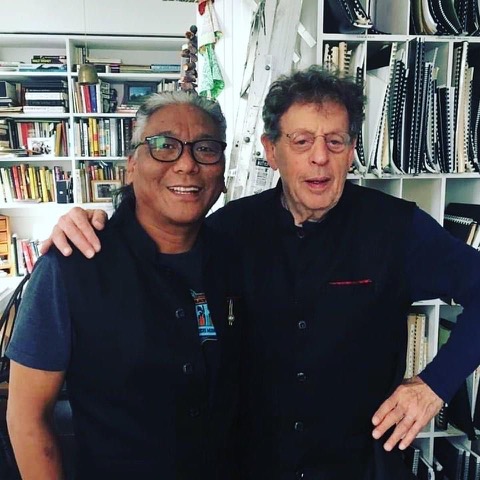A Song for His Holiness
On “Snowy Mountains-GangRi,” Tenzin Choegyal, Philip Glass, and the Tibetan Children’s Village pay homage to the Fourteenth Dalai Lama. The post A Song for His Holiness appeared first on Tricycle: The Buddhist Review.

As an offering to His Holiness the Dalai Lama on the occasion of his 90th birthday, Tenzin Choegyal, one of the world’s foremost Tibetan musicians, collaborated with legendary composer Philip Glass to set one of the best-known traditional long-life prayers for His Holiness to music. “Snowy Mountains-GangRi” is sung by Tenzin Choegyal alongside one hundred children of the Tibetan Children’s Village in Dharamsala, where Tenzin himself grew up. The song features Alex Ring Gray, who coproduced the song, on piano, and the Grammy-winning Scorchio Quartet.
Offering long-life prayers for spiritual teachers is a traditional practice in Tibetan Buddhism. They are recited both in groups during important ceremonies and rituals and by individuals as part of private daily meditation practice. Long-life prayers are believed to help extend the life force of highly realized teachers, strengthen students’ connection to their teachers, accumulate merit, and support the spread of the teachers’ virtuous dharma activities in order to benefit countless sentient beings.
“Snowy Mountains-GangRi” is an expression of prayerful devotion to one’s spiritual guru and a heart-opening meditation on spiritual joy and connection. Recently, I had the opportunity to sit down with Tenzin Choegyal to discuss the intentions behind the song, how the children of Tibetan Children’s Village are the “heroes” of the song, and the positive ripple effects he hopes the song will have in the world.
What can you tell us about the inspiration for the song? The song itself is a beautiful prayer, a long- life prayer for His Holiness the Dalai Lama. In a very humble way, I knew that His Holiness’s 90th birthday was coming up, and in the back of my mind, I was thinking of how to pay homage to his legacy. I thought that the best way to do that would be to make a humble little tune that would also resonate with other people. The song pays homage to the works of His Holiness the Dalai Lama, for how fortunate we are to be walking on this planet with him while he’s with us.
The prayer is four lines, the shortest long-life prayer for His Holiness. “In the land encircled by the snowy mountains, you are the source of happiness and benefit for all the sentient beings.” If you ask any Tibetan, they will know the stanza.
You wanted the voices of the children of the Tibetan Children’s Villages to be a part of the song because of His Holiness’s role in starting the schools, is that right? Yes. It’s one of the first things that he did when we Tibetans came into exile. He set up schools for the Tibetan kids [the Tibetan Children’s Villages].
In the back of my mind, I thought, “I don’t want the song to be just me singing. It has to be something more.” The voices of the kids have so much innocence and so much purity, without any of the defenses that develop when one has grown up. I’ve sent the song to a couple of my music friends who don’t know anything about Tibet. Each time, they said that as soon as the voices of the kids come in, it makes their heart warm and gives them goosebumps. That’s exactly what I wanted, for the kids to be the hero of this piece, the ones who are offering the long-life prayer to His Holiness the Dalai Lama.
In the initial part of the song, you will hear the children are a little off-key with their singing, and the innocence in that is so beautiful. So I asked my sound engineer not to auto-tune the kids, just to keep the purity of what they sounded like.
The kids probably don’t know who Philip Glass is anyway. But when they grow up, they’ll realize, “Oh, we have done this song with Philip Glass.” I wanted to introduce the kids to Philip’s work, because Philip has been an amazing friend of Tibet. And he’s an amazing Buddhist practitioner himself. I would say he’s a much better practitioner than I am.
What can you tell us about the music and the structure of the song? The song starts with me singing, in my nomadic kind of lineage sound, that’s inviting all the deities. So before the kids come in, you will hear that the deities are being asked to come. Inviting all the deities of the skies and the mountains and the rivers, the deities and the nagas that live in the water. It’s kind of like the slow part of the song is asking all the deities and the nagas to come and be part of the song as well.
I can picture all of this in my head, but I can’t really show the things that I see in my mind. It’s like there’s a whole movie going on in my mind, with all these deities coming to join with the kids and with Philip, and then taking the song to His Holiness. I like visualizing things. So, yeah, in the song, those were the visualized things that I do.
The instrument of the piece is the Tibetan dranyen. Dranyen is a very beautiful, simple instrument that carries almost every Tibetan story in a song. How amazing it is for me to be able to introduce dranyen into the world of classical music and make the dranyen part of that family.
 A Tibetan dranyen. Image courtesy Tenzin Choegyal.
A Tibetan dranyen. Image courtesy Tenzin Choegyal.When you listen to it, it’s like, slowly, slowly, you will be able to hear what Philip is doing on the piano and the strings that blend so beautifully with the dranyen.
What was it like recording the song with the children? Did you travel to Dharamsala and actually do it at the Tibetan Children’s Village? Yes. When we were recording, suddenly there would be kids pulling each other’s ears, elbowing each other, things like that. It reminded me of myself. Whenever I go back to Tibetan Children’s Village in Dharamsala, it takes me back to my childhood when I was there. So working with them is like tracking back to your own childhood and seeing yourself in them and how innocent you were. It’s a teaching in and of itself. It reminds you to be a kid again. The nature of being a kid is that they don’t have the covering of egos that we have built, the coverings of attachments that we have built, or the armor. So all these walls we have built around ourselves, whenever you see a kid sing or pray, that armor melts down. It’s a great reminder of what beautiful beings we all are. But a lot of the time, we forget that those parts exist.
The kids’ singing sounds like it really brought out the devotional aspect of the prayer in the song. As an artist, we do have these egos built around us. And so for me, bringing the kids in is like the dismantling of the whole ego, dissolving into being a kid again. The whole song actually is owned by them in a way, even though you can say that Philip and I were part of it. But the kids totally own the song. Whoever is listening, they will definitely go, “Wow. These kids are so beautifully innocent and heartwarming.”
The nature of being a kid is that they don’t have the covering of egos that we have built, the coverings of attachments that we have built, or the armor. …Whenever you see a kid sing or pray, that armor melts down. It’s a great reminder of what beautiful beings we all are.
Devotion is so pure and so warm and open. Kids have that capacity. We have to remember how to be kids again, I think, in order to be really devoted, to have that kind of purity of heart.
The song is really an expression of your guru devotion. Oh, absolutely. It’s a guru devotion from my side, yes, for my root guru, and then at the same time, for my musical collaborator, Philip, who is 88. And then aspiring to be like His Holiness.
 Tenzin Choegyal and Philip Glass. Image courtesy Tenzin Choegyal.
Tenzin Choegyal and Philip Glass. Image courtesy Tenzin Choegyal.What do you want the listener to experience when they hear the song? I want, when any Tibetan or any dharma practitioner hears the kids sing, to think, “We know those lines,” and they can start singing too. It encourages them to also be part of this long-life prayer.
I think as soon as listeners hear it, they will be able to sing it as well, because the melody is very simple. I intentionally kept the part that the kids sing simple so that anyone who starts listening to it will be able to sing it as well.
When you hear the song, I would like people to think about the legacy of His Holiness. This is my motivation. I don’t know where the listeners will take their own journey, but my motivation is to instill a little bit of His Holiness in everyone—even if we have only 1% or 2% of His Holiness’s mental attributions.
What is your hope for how this song is received in the world? I wish we all can be even a little percentage of what His Holiness is like. Then the world would be a better place. I think there are many people I know, beings like you, like many of my dear friends that are on that path, the compassionate path. I’m surrounded by that, but at times, you kind of become discouraged by seeing disillusioned, ignorant leaders in the world.
I think it would be amazing to shift the negative focus that we are giving so much time to and to shift it to these beings who lift up humanity, who lift up the compassionate, awakened mind that we have in ourselves. So the beings that lift this up, we celebrate them, and we acknowledge them, and we actually amplify their voice and amplify their legacy. Then it gives no space for negative beings, but it might actually give them a boost of awakening toward their own better self by seeing what’s being celebrated.

 MikeTyes
MikeTyes 
































